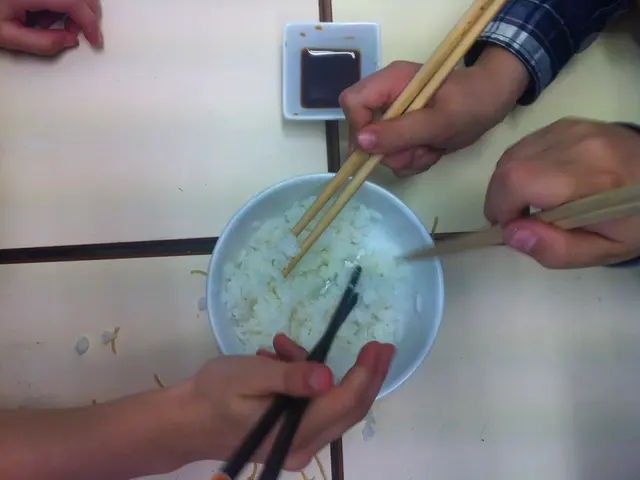Instructions for Crafting Balanced and Authentic Bonsai, Emphasizing Structural Harmony and Classical Beauty
Mastering the Art of Formal Upright Bonsai
The Formal Upright style, also known as Chokkan in Japanese, is a popular choice for bonsai enthusiasts seeking a refined and elegant tree. This style is characterized by its conical shape, straight trunk, and symmetrical branching pattern. Here's a guide to growing and shaping a Formal Upright Bonsai.
Suitable Tree Species
Choosing the right tree species is crucial. Pines, junipers, spruces, larches, and some maples are recommended due to their natural ability to grow strong, straight trunks with smooth tapering and symmetrical branch placement [1][5]. Juniperus chinensis 'Glauca', for instance, is prized for its compact growth, silvery-blue needle foliage, and resilience [4]. Even tropical broadleaf evergreens like the Dwarf Black Olive (Bucida spinosa) can be trained into formal upright styles [2].
Key Characteristics
The trunk of a Formal Upright Bonsai must be perfectly straight and taper smoothly from a thick base to a slender apex, creating a clear, elegant conical shape [1]. Branches are arranged symmetrically, often in a triangular or conical pattern, with the lowest branch longest and the upper branches progressively shorter. They emerge roughly at right angles and taper similarly to the trunk, achieving balance and harmony when viewed from all angles [1].
Caring for a Formal Upright Bonsai
To grow a Formal Upright Bonsai tree indoors year-round, proper care including controlled temperature, humidity, and lighting is essential. The ideal temperature range is 15-25°C (59-77°F), and the humidity level should be maintained between 40-60% [3].
Wiring techniques are essential for refining the shape of a Formal Upright Bonsai, enabling precise control of branch placement and direction. The appropriate wire gauge should be selected, considering factors such as branch size, tree species, and desired movement [1].
Shaping the Tree
Creating a formal upright bonsai from scratch takes anywhere from 5 to 20 years, depending on the tree species, growth rate, and consistent application of proper pruning, wiring, and care techniques [1]. Balance and symmetry are essential guidelines for shaping primary branches, with primary branches evenly spaced and balanced to create a sense of harmony.
Branch symmetry matters in reinforcing the sense of balance and harmony in a Formal Upright Bonsai, with strategic placement of branches creating a sense of order and harmony. Branch length and proportion should be controlled to maintain proportion and balance, with each branch shorter than the one below it [1]. Branch angle and direction should be pruned to grow at a 45-degree angle, slightly upwards, to create a gentle, sweeping curve [1]. Balanced foliage distribution is essential to creating harmony between the branches and leaves of a Formal Upright Bonsai, achieved by carefully pruning and training the foliage to create a visually appealing distribution of mass and void [1].
Challenges and Solutions
Common challenges in creating a Formal Upright Bonsai include uneven trunk taper, inadequate branch placement, weak apical dominance, insufficient pruning, and poor wiring techniques. Foliage density, leaf size and shape, branching patterns, and negative space are key factors in achieving balanced foliage distribution [1].
Beyond Aesthetics
The Formal Upright Bonsai transcends mere aesthetics, becoming a meditation on the essence of existence. It is a testament to patience, skill, and the harmonious relationship between man and nature.
[1] Bonsai Empire. (2021). Formal upright style. Retrieved from https://bonsaiempire.com/bonsai/styles/formal-upright/
[2] Bonsai Tonight. (2021). Dwarf black olive bonsai. Retrieved from https://www.bonsaintonight.com/dwarf-black-olive-bonsai/
[3] The Bonsai Garden. (2021). How to care for a formal upright bonsai. Retrieved from https://thebonsaigarden.com/how-to-care-for-a-formal-upright-bonsai/
[4] Bonsai4me. (2021). Juniperus chinensis 'Glauca' bonsai. Retrieved from https://bonsai4me.com/juniperus-chinensis-glauca-bonsai/
[5] Bonsai Bark. (2021). Best trees for formal upright bonsai. Retrieved from https://bonsaibark.com/best-trees-for-formal-upright-bonsai/
- For those interested in lifestyle and hobbies, mastering the art of Formal Upright Bonsai offers an opportunity for self-development and growth.
- As fashion-and-beauty enthusiasts may appreciate, the Formal Upright style boasts a refined and elegant appearance, mimicking the symmetry found in clothing designs and makeup.
- Food-and-drink connoisseurs can take delight in pairing a well-manicured Formal Upright Bonsai with a zen-inspired setting for indoor dining, adding a touch of tranquility to mealtime.
- Home-and-garden enthusiasts will find a suitable spot for their new Formal Upright Bonsai, as it complements contemporary and traditional interior design, serving as a conversation piece amidst their beloved pets and artificial or natural elements.
- Weather conditions play an important role in caring for Formal Upright Bonsai, with ideal temperatures, humidity levels, and lighting vital for the tree's growth and health.
- Expanding one's education and knowledge on various aspects of life, such as gardening and aesthetics, sport enthusiasts might take an interest in learning the methods to cultivate and shape a Formal Upright Bonsai, whether for personal enjoyment or competition in specialized events.




